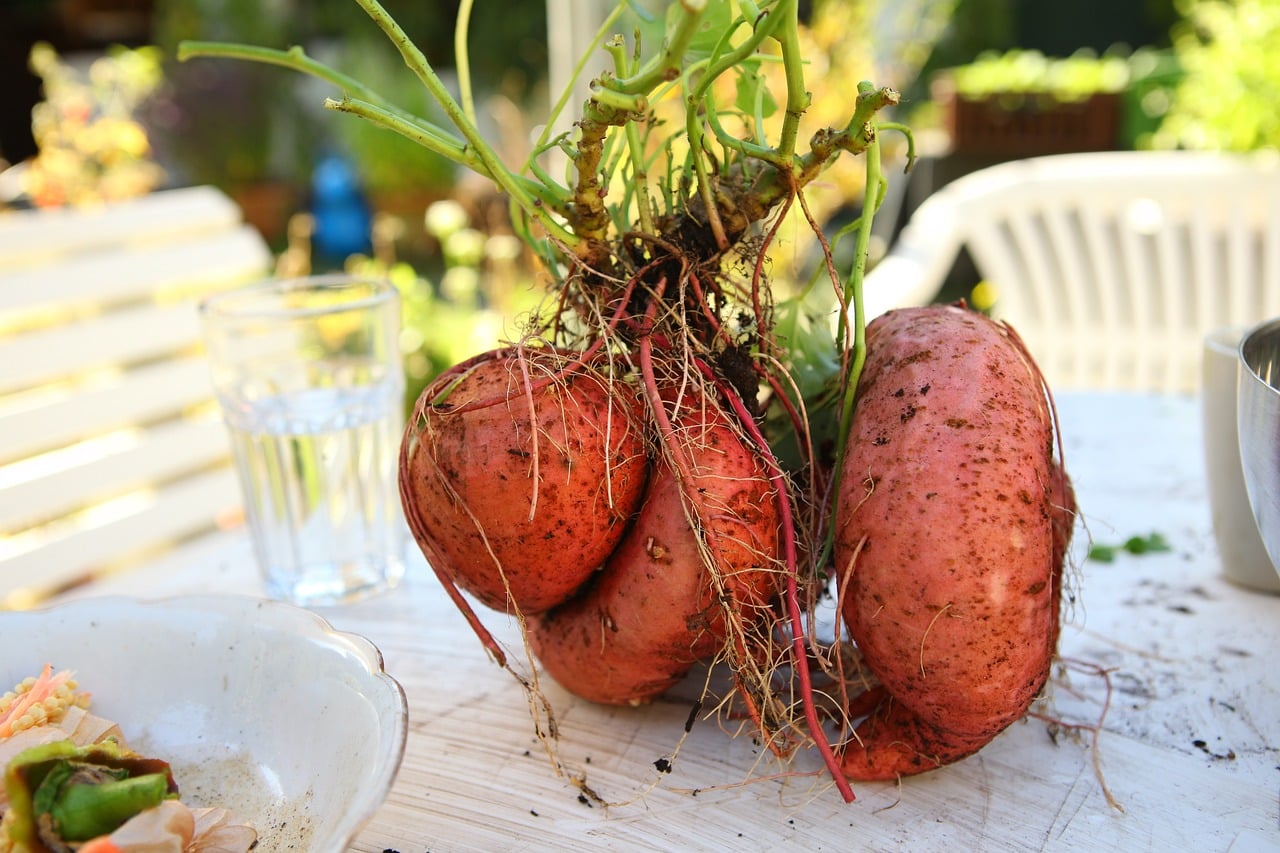Sweet potatoes, the symbol of abundance and nourishment, have been a staple in kitchens around the world for centuries. This beloved root vegetable is not only delicious, but it is also a great addition to any backyard garden. Growing sweet potatoes can be a rewarding experience that produces tender, sweet vegetables right from your own backyard. Whether you are an experienced gardener or just starting out, this guide will provide you with all the tips and tricks on how to grow sweet potatoes successfully.
With their vibrant purple skin and orange flesh, sweet potatoes are not only beautiful but also highly nutritious. They are an excellent source of dietary fiber and Vitamin A as well as containing many other essential vitamins and minerals. And with so many varieties available, there is sure to be one to fit every palate! From creamy white-fleshed varieties to deep purple-skinned types, there is something for everyone when it comes to growing sweet potatoes at home.
With just a few simple steps and some basic supplies, you can easily get started growing your very own sweet potato crop in no time. This guide will provide all the information you need to know about planting, caring for, harvesting, and storing your sweet potatoes so that you can enjoy them throughout the season with family and friends!
1. Preparing The Soil For Sweet Potatoes
Gardening can be both a therapeutic and rewarding experience, especially when it comes to growing sweet potatoes. With the right preparation, you will be able to enjoy their unique and delicious sweetness in no time. So let’s get started with the basics: preparing the soil for sweet potatoes.
When it comes to soil preparation, there are several important factors to consider. First and foremost, your soil should have plenty of organic material such as compost or manure. This will help ensure that your sweet potatoes have enough nutrients for optimal growth. You also want to make sure that your soil is well-drained so that your plants do not become waterlogged and susceptible to root rot or other diseases. Finally, you want to make sure that the pH of your soil is between 5.5 and 6.5; this will provide ideal conditions for growing sweet potatoes.
With these considerations in mind, it’s time to get started! Get out a shovel or tiller, remove any weeds from the area where you’ll be planting your sweet potatoes, then add in organic materials and mix them into the soil until it is soft and loose. You may also want to spread some fertilizer over the top of your garden bed before planting; this will help give your plants an extra boost of nutrition throughout their growing process.
Now that you’ve taken care of the basics for soil preparation, you should move on to choosing the right varieties of sweet potato for your garden—a step which can have a significant impact on how successful you are at harvesting tasty tubers!
2. Choosing The Right Sweet Potato Varieties
Choosing the right sweet potato variety is an important step in growing your own sweet potatoes. There are many varieties available, each with different characteristics and benefits depending on your needs. Knowing which type to choose can help you get the most out of your sweet potatoes. Here’s a look at five popular options:
The Beauregard sweet potato is a great choice for beginners. It has high yield potential and produces large roots that are easy to harvest. This variety also has good storage qualities, making it an ideal choice for long-term storage.
The Bonita sweet potato is known for its beautiful purple skin and bright orange flesh. It has good disease resistance and produces medium-sized tubers with a unique flavor profile when cooked.
If you’re looking for an heirloom variety, the Georgia Jet is a great choice. It has excellent flavor and offers plenty of nutrition in each serving, making it an ideal addition to any meal plan. The roots are medium-sized and have a dark red skin that makes them visually appealing as well as delicious!
For those who want something a little more exotic, there’s the Okinawan sweet potato. This variety contains high levels of antioxidants and vitamins A and C, making it a nutritious addition to any diet. Its vibrant purple color also makes it look stunning when served on a plate!
Finally, there’s the Jewel sweet potato which is known for its deep orange color and creamy texture when cooked. The Jewel has good disease resistance and produces large tubers with lots of flavor!
Each variety offers something special that can make your sweet potatoes stand out from the rest – so take some time to consider what type would fit best in your garden!
3. Planting Sweet Potatoes From Slips
Planting sweet potatoes from slips is an easy way of growing this delicious vegetable. It’s a great option for novice gardeners and those with limited space.
The process begins with the purchase of certified sweet potato slips. These can often be purchased at local nurseries, or they can be ordered online. Once you have your slips, it’s time to get planting! The best time to do so is in early spring when the soil has begun to warm up.
Before you plant, make sure the soil is well-prepared by adding compost and tilling it to create loose soil. Then, place your slips in the ground approximately 6 inches apart. Cover them up with a few inches of soil and water regularly until they take root. With proper care and attention, you’ll soon have a bountiful harvest of sweet potatoes in your backyard!
Now that you know how to plant sweet potatoes from slips, let’s look at another method: planting from tubers.
4. Planting Sweet Potatoes From Tubers
Interestingly, some sweet potato plants can yield up to 100 pounds of potatoes per 10-foot row! Planting sweet potatoes from tubers is a great way to get started with this bountiful crop.
When planting from tubers, the process begins with choosing healthy specimens that are free from bruises, cuts, or soft spots. You’ll want to pick firm and smooth sweet potatoes for best results. The next step is to cut each tuber into two-inch pieces, making sure each piece has at least one healthy eye on it. Once your pieces are ready, you’ll need to let them sit in a warm and dry environment for a day or two. This allows the cut pieces to heal over and form a protective barrier against disease.
Finally, once the pieces have healed over it’s time to plant them in the ground. Depending on your region, you may be able to plant them directly into the soil; otherwise you will need to start them off in containers first and then transplant them outdoors once they’re more established. When planting your sweet potato tubers make sure they are buried at least four inches deep and spaced 12 inches apart.
Spacing your sweet potato plants correctly will help ensure they have space for plenty of growth throughout the season!
5. Spacing Sweet Potato Plants In The Garden
When it comes to planting sweet potatoes in your backyard, spacing is an important factor. For example, if you have a large backyard and plenty of room for your garden, you can space your sweet potato plants up to three feet apart. This allows for adequate sunlight and air circulation, which helps promote healthy growth.
However, if you have limited space or a small garden, it’s important to adjust the spacing accordingly. In this case, your sweet potato plants should be spaced at least one foot apart so they don’t overcrowd each other and impede their growth. When planting multiple rows of sweet potatoes, make sure to leave enough space between them for easy access during maintenance and harvesting.
No matter the size of your garden or the amount of space available, proper spacing is essential for getting the most out of your sweet potato plants. It’s also important to remember that while these guidelines will help maximize yield and quality, there’s still some trial and error involved as you get accustomed to growing sweet potatoes in your own backyard. Now that we’ve discussed spacing sweet potato plants in the garden, let’s look into how best to maintain them.
6. Maintaining Sweet Potato Plants
How should you maintain your sweet potato plants once they have been planted in the ground? After all, it’s not just about getting them in the soil and leaving them be, is it? To ensure a successful harvest and healthy plants, there are few key steps that need to be taken.
Firstly, water your sweet potatoes regularly. Watering your plants deeply every 3-4 days will give them the hydration that they need to thrive. Make sure that you don’t overwater them, as this can lead to root rot or other diseases. If you get into the habit of checking the soil moisture before watering, this will make it easier for you to gauge how much water they need.
Secondly, mulch around your sweet potatoes with hay or straw. This helps to keep weeds at bay and conserve soil moisture. It also helps insulate the roots from temperature fluctuations and prevent fungal diseases from attacking the roots during humid weather. Be sure to keep a few inches away from the stems of your plants so that air can circulate freely around them.
Finally, monitor your plants for pests or disease throughout their growing season. Aphids and whiteflies can cause damage to the leaves if left unchecked, so make sure you inspect the foliage often and take action if necessary. If you notice any discolored spots on the leaves or stems, contact your local extension office for advice on how to treat it safely and effectively.
7. Fertilizing Sweet Potatoes
Cultivating sweet potatoes is a rewarding and fulfilling activity – one that can be both enjoyable and beneficial for your home. Taking the time to properly fertilize your sweet potatoes will ensure their healthy growth, so it’s important to understand the basics of fertilizing them.
Fertilizing sweet potatoes is relatively straightforward, but there are a few key points to keep in mind when doing so. To begin with, you’ll want to use an organic fertilizer specifically designed for root crops. This type of fertilizer will help promote healthy roots and foliage growth throughout the season. Additionally, it’s important to remember not to over-fertilize, as too much can cause nutrient burn or even damage the plant. Instead, use moderate amounts at regular intervals throughout the growing season for optimal results.
Finally, be sure to provide your sweet potatoes with plenty of organic matter such as compost or mulch around their base as this will help retain moisture and reduce weeds. With these tips in mind, you’ll be well on your way towards cultivating a successful crop of sweet potatoes! Moving on to watering…
8. Watering Sweet Potatoes
Now that you’ve learned how to fertilize your sweet potatoes, it’s time to get to the next step: watering. Your sweet potatoes will need plenty of moisture in order to thrive. While they don’t require a lot of water during the growth process, you’ll want to ensure that the soil stays moist throughout their growing season. This means watering regularly and deeply so that the roots can easily access the moisture they need.
When watering your sweet potatoes, avoid getting the foliage wet as this can lead to fungal diseases such as blight or leaf mold. Instead, focus on keeping the soil around the roots moist and well-drained. Don’t forget to apply a layer of mulch around your plants too – this helps retain moisture and protect them from temperature fluctuations and weeds.
Watering your sweet potatoes is an important part of ensuring they grow healthy and strong. By providing enough moisture, you’re giving them their best chance at producing a good harvest. With proper care and attention, you’ll be able to enjoy delicious sweet potatoes right from your backyard! Now let’s look at how we can keep weeds away from our precious crop so they can have room to grow without any competition.
9. Controlling Weeds Around Sweet Potatoes
Weeding around sweet potatoes can be an arduous task that often requires time and dedication. But, it doesn’t have to be! Controlling weeds around your sweet potatoes can help maximize their growth potential and also keep your garden looking tidy. Here are five tips you can use to make weeding easier:
- Hand-weed regularly: Pulling weeds by hand is the most effective way to control them, so be sure to do this at least once a week or more during the growing season.
- Use mulch: Adding a layer of mulch around your sweet potatoes can help prevent weed seeds from germinating and reduce competition for nutrients and water.
- Plant densely: Plant your sweet potatoes close together in beds, as this will reduce the amount of space available for weeds to grow in.
- Cover young plants with straw or newspaper: This helps keep weeds from taking over when your plants are still young and vulnerable.
- Invest in an herbicide: If all else fails, using an herbicide specifically formulated for vegetable gardens is a fast and effective way of controlling weeds without having to spend hours pulling them out by hand.
These five tips should help you manage the pesky weeds in your garden while allowing your sweet potato plants the space they need to grow healthy and strong! By keeping up with regular weeding, mulching, planting densely, covering young plants, and investing in an herbicide if necessary, you’ll be well on your way to having a successful crop of sweet potatoes this year! Now let’s take a look at how mulching can help boost the success of your sweet potato harvest…
10. Mulching Sweet Potatoes
Oh my goodness! Growing sweet potatoes is like a dream come true! Mulching sweet potatoes is the icing on top of an already amazing cake. It’s almost too good to be true!
Mulching sweet potatoes helps to keep the soil moist and control weeds. It also keeps temperatures consistent for roots to develop properly. In general, organic mulches work best for sweet potato beds – such as straw, grass clippings, or wood chips. If you use wood chips, make sure they are not from treated wood because this can leach into your soil and affect the taste of your sweet potatoes.
When mulching, it’s important to leave a few inches around the plants so that the leaves can still get some sun exposure and air circulation. This helps with disease prevention and healthy plant growth. Lastly, don’t forget to water your sweet potatoes regularly – even when mulching – so that they receive enough moisture throughout their growing season.
Mulching is a great step towards helping your sweet potato plants reach their full potential while keeping weeds at bay! Next up in this journey? Controlling pests and diseases – something we’ll discuss more in depth soon.
11. Controlling Pests And Diseases
Some may feel overwhelmed by the thought of controlling pests and diseases when it comes to growing sweet potatoes in their backyard. However, with a bit of knowledge and dedication, you can rest assured that your harvest will be healthy and delicious.
Firstly, it’s important to understand the various types of pests and diseases that could affect your crop. This includes things like slugs, aphids, fungus, root knots, and more. Knowing which ones are most likely to affect your area will help you take proactive steps to prevent them from causing any damage.
Another key factor is maintaining a well-maintained garden – this means keeping weeds down, ensuring adequate drainage so roots don’t rot, and avoiding overcrowding of plants. Additionally, you should also rotate crops on a regular basis in order to break up disease cycles and keep insects under control. Finally, make sure to use natural pest repellents or biological controls if needed – as these are much safer for both you and the environment than chemical pesticides.
With these simple tips in mind – along with an ongoing commitment to monitoring your plants for signs of infestation or disease – you can confidently look forward to harvesting sweet potatoes that are healthy and abundant!
12. Harvesting Sweet Potatoes
When it comes to harvesting sweet potatoes, timing is key. Did you know that the average sweet potato harvest time can range from three to four months? That’s why it’s important to be patient and wait until the plants have fully matured before harvesting.
Now that you know when to harvest your sweet potatoes, let’s talk about how. The best way to harvest sweet potatoes is by gently digging them up with a spade or garden fork. Be sure not to dig too deep and damage the tubers! When you’ve harvested all of the potatoes in one area, you can move on to another spot.
Once they are harvested, it’s important to store them properly so they don’t spoil before you’re ready to use them. Storing sweet potatoes correctly will help keep them fresh for several weeks or even months after harvest!

13. Storing Sweet Potatoes
Most gardeners look forward to the moment when they can finally harvest their sweet potatoes, but there’s still one more important step: storing them properly. With the right technique and knowledge, you can extend their shelf life and enjoy them throughout the year.
Imagining yourself with your hand-picked sweet potatoes, you’ll want to make sure they last as long as possible. Start by selecting only mature sweet potatoes that are firm and free of any blemishes or soft spots. Once harvested, be sure to clean them with a damp cloth to get rid of any dirt or debris. It is also important to let them dry in the sun for a few days before storage.
Now it’s time to store those sweet potatoes! Place them in a cool, dark place with good air circulation — this could be a root cellar or even a closet or pantry if necessary. The ideal temperature range for storing sweet potatoes is 50-60 degrees Fahrenheit, so keep this in mind when looking for an ideal spot for storage. Be sure not to stack them too closely together because this can cause molding or rot over time.
TIP: If you need to stack them due to limited space, use newspaper between each layer so that air can circulate freely around the tubers. Keeping up with these simple steps will ensure that your sweet potatoes stay fresh and delicious all year round!
14. Cooking With Sweet Potatoes
Cooking with sweet potatoes is a great way to use the bounty of your backyard harvest. Not only are they delicious, but these root vegetables are also incredibly nutritious and versatile. From roasting to mashing, there’s something for everyone!
When it comes to cooking with sweet potatoes, you can’t go wrong with simple roasting. All you need is some olive oil, salt and pepper and you’ve got a delicious dish! Of course, if you’re feeling adventurous, why not try out some creative recipes? Add them to soups or stews for added flavor and nutrition. Or turn them into fries for a fun snack. The possibilities are endless!
For even more nutritional benefits, try steaming your sweet potatoes before adding them to your dishes. This method helps preserve all of their vitamins and minerals while still allowing them to be cooked quickly and easily. So don’t forget about this delicious veggie when planning meals – it’s sure to please the whole family! And now that you know how to cook with sweet potatoes, let’s move on to composting the plants…
15. Composting Sweet Potato Plants
Composting sweet potato plants is a great way to help the environment and your garden. According to The National Gardening Association, up to two-thirds of household waste can be composted, reducing the amount of material going into landfills. Composting not only helps reduce waste, but it also provides essential nutrients for your sweet potatoes and other plants in your garden.
Composting sweet potato plants is an easy process that anyone can do. To get started, collect organic materials such as vegetable scraps, coffee grounds, egg shells, and grass clippings. Place the materials in a compost bin or pile them outside in your backyard. If you want faster results, you can use a compost activator like worms or bacteria to speed up the decomposition process. It’s important to keep the compost moist and aerated by turning it regularly so that oxygen can reach all parts of the compost pile.
Once you have your compost ready to go, spread it around the base of your sweet potato plants at least once a year. This will provide them with essential nutrients they need to thrive and produce delicious potatoes! Additionally, adding a layer of mulch around your sweet potato plants will help retain moisture and keep weeds away. By taking these simple steps you’ll be able to enjoy homegrown sweet potatoes for years to come!
Frequently Asked Questions
What Type Of Soil Is Best For Growing Sweet Potatoes?
Growing sweet potatoes is becoming an increasingly popular gardening endeavor. Did you know that, according to the USDA’s National Agricultural Statistics Service, the US produced 1.2 billion pounds of sweet potatoes in 2018? That’s a lot of spuds! It is no surprise then that there are many people out there looking for tips on how to grow their own sweet potatoes.
When it comes to growing sweet potatoes, one of the most important things you need to consider is the type of soil you use. The best soil for growing sweet potatoes has good drainage and is rich in organic matter. It should also be slightly acidic with a pH between 5 and 6.5, which can easily be tested with a home soil test kit. Here are some other factors to keep in mind when selecting your soil:
• Make sure the soil is free of rocks and debris;
• Add plenty of compost or aged manure before planting;
• Mix in some peat moss and ground limestone for extra nutrients;
• Use mulch around plants to help retain moisture;
• Avoid using fresh manure as this can burn young plants.
By choosing the right soil type for your sweet potato plants, you can ensure that they thrive and produce abundant yields year after year. With proper care and attention, you can have a bountiful harvest from your very own backyard!
How Long Does It Take For Sweet Potatoes To Mature?
Ah, the sweet potato – an age-old vegetable that has been around for generations. We’ve all heard of it and we all know someone who grows it in their backyard. But how long does it take for sweet potatoes to mature? It’s a question that many people have when they’re starting out in their own backyard gardening journey.
Irony aside, let’s get to the nitty-gritty:
- Sweet potatoes need warm weather and lots of sunlight, so they are typically planted late in the spring or early summer.
- Maturing time can vary depending on climate and variety, but generally takes between 90-120 days under ideal conditions.
- Varieties such as Beauregard or Georgia Jet will be ready in around 90 days while varieties such as Covington or Jewel may take up to 120 days.
- If planted too late in the season (late summer/early fall), you may get fewer yields due to shorter daylight hours.
When planting your sweet potatoes, it’s important to remember that faster maturing varieties will produce smaller yields than those that take longer – so if you want large amounts of sweet potatoes, look for slower maturing varieties! And make sure to give them plenty of room to spread out – overcrowding can lead to smaller yields and more disease problems.
It’s also important to note that harvesting sweet potatoes is a bit different from other vegetables – they should not be harvested immediately after maturity, but instead should be left in the ground for an additional 2-3 weeks after they are mature so that their skin hardens and their flavor develops fully. After this time period, you can harvest your sweet potatoes with ease! So don’t expect instant gratification; with some patience you’ll be rewarded with delicious homegrown sweet potatoes soon enough!
How Do I Know When Sweet Potatoes Are Ready To Harvest?
Growing sweet potatoes can be incredibly rewarding, and harvesting them is the cherry on top! Knowing when your sweet potatoes are ready for harvest is key to getting the most out of your gardening efforts.
The first step in detecting when your sweet potatoes are ready for harvest is to know how long it takes for them to mature. Typically, they can take anywhere from 90-170 days depending on the variety and climate. Keep an eye out for signs such as yellowing leaves and dying vines, which can indicate that they are close to being ready.
You’ll also want to check the size of the tubers. Sweet potatoes should be large enough that you can easily dig them up with a garden fork or spade. If you notice their size isn’t changing much over time, then it could mean they’re not quite ready yet and need more time in the ground before harvesting. To ensure a successful harvest, wait until after the first frost has passed so that the sweet potatoes have had time to fully mature – just like a fine wine!
Harvesting sweet potatoes may seem intimidating at first, but with patience and careful observation it can be done with ease. Just remember that if you follow these steps, you’ll have plenty of delicious sweet potatoes on your plate in no time!
What Kind Of Fertilizer Is Best For Sweet Potatoes?
Did you know that sweet potatoes are one of the most nutrient-dense vegetables? They are packed with vitamins, minerals and antioxidants that are essential for a healthy body. With this in mind, it’s no wonder so many people are interested in growing them in their own backyard! But what kind of fertilizer is best for sweet potatoes?
When it comes to fertilizers, there is no one-size-fits-all solution for sweet potatoes. It all depends on your soil and climate conditions. Generally speaking, an organic fertilizer like compost or manure is recommended for sweet potatoes. This will help provide the necessary nutrients and help improve soil texture as well. If you don’t have access to organic fertilizers, you can use a balanced chemical fertilizer such as 10-10-10.
It’s also important to remember that too much fertilizer can be just as bad as not enough. Too much nitrogen can result in lush foliage but fewer tubers. To avoid this, make sure to follow the instructions on the label closely and use a soil test kit to measure the pH levels of your soil before applying any fertilizer. With careful preparation and attention to detail, you’ll be able to provide your sweet potatoes with all they need to thrive!
Are There Any Companion Plants That Help Sweet Potatoes Grow Better?
Like a gardener carefully tending to their crops, companion plants provide the perfect environment for sweet potatoes to thrive. Growing with the help of companion plants can be a rewarding experience that yields delightful results.
Similar to the way friends are drawn together by shared interests and values, companion plants provide sweet potatoes with the necessary elements for optimal growth. Planting companion plants like marigolds, okra, or nasturtiums will not only enrich the soil but also attract beneficial insects to ward off any pests that may try to attack your sweet potatoes. Additionally, they can reduce weed growth and help retain moisture in the soil.
In order to achieve success with companion planting, it is important to think about what kind of nutrients each plant needs and how they can benefit one another. For instance, marigolds create a nutrient-rich environment while okra helps improve drainage in heavier soils; when planted together they form an ideal setting for growing sweet potatoes. With careful planning and consideration of how each species interacts with each other and the overall ecosystem, you can create a garden oasis that produces vibrant sweet potatoes.
Conclusion
Growing sweet potatoes in your backyard can be an enjoyable and rewarding experience. With the right soil, fertilizer, and companion plants, you can easily grow a bounty of delicious sweet potatoes in no time. But it’s important to remember that patience is key when growing sweet potatoes. It may take some time for the crop to mature and for the tubers to be ready for harvest.
With a little bit of knowledge and effort, you’ll soon have your own homegrown sweet potatoes that are sure to impress family and friends alike. As the old adage goes, “The more you put into something, the more you get out of it” – this applies perfectly to growing sweet potatoes in your backyard. The more effort and care you put into nurturing your crop, the bigger and better tasting your yield will be.
Overall, with some research, planning and dedication – growing sweet potatoes in your backyard can provide great success! All it takes is some knowledge on how to properly grow them, along with a healthy dose of patience and care. So why not give it a try? You won’t regret it!





























